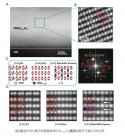CAS Microelectronics has made important progress in hafnium oxide-based ferroelectric storage materials.
The rapid development of information technologies such as the Internet and artificial intelligence has put forward higher requirements for the storage density, access speed and number of operations of the memory. Hafnium oxide-based ferroelectric memory has the advantages of low power consumption, high speed, and high reliability, and is considered as a potential solution for the next generation of non-volatile memory technology. Orthorhombic phase (orthorhombic phase , referred to as "o phase " ) HfO 2 -based ferroelectric materials that are widely studied now, due to their own high ferroelectric flipping potential barrier and " independent flipping " dipole flipping mode, devices based on this ferroelectric material It has a high coercive field, which leads to problems such as the incompatibility of the operating voltage of the device with the advanced technology node, and the limited number of erasing and writing times. This problem is based on the intrinsic properties of o -phase HfO2 - based ferroelectric materials, which is difficult to solve by conventional optimization processes. Therefore, finding a HfO2 - based ferroelectric material with stable structure and low flipping barrier is an urgent problem to be solved.
In response to this problem, the team of academician Liu Ming of the Key Laboratory of Microelectronic Devices and Integrated Technology and the team of researcher Du Shixuan of the Institute of Physics, Chinese Academy of Sciences discovered a stable ferroelectric trigonal phase Hf(Zr) 1+x O 2 material structure , This structure lowers the flipping barrier of ferroelectric dipoles in HfO2 - based ferroelectric materials. Through first-principle calculations based on density functional theory ( DFT ), it is found that when the ratio of Hf(Zr) to oxygen in Hf(Zr) 1 + x O 2 material is greater than 1.079 : 2 , the formation energy of the trigonal phase is low In the formation energy of ferroelectric o- phase and monoclinic phase ( m -phase). Scanning transmission electron microscopy ( STEM ) experiments clearly revealed the crystal structure of excess Hf(Zr) atoms embedded in the ferroelectric trigonal lattice, confirming the results of theoretical calculations. The embedded Hf(Zr) atoms expand the lattice, increase its in-plane and out-of-plane stresses, and play a role in stabilizing the structure of Hf(Zr) 1+x O 2 materials and lowering their ferroelectric flipping barrier. Based on Hf(Zr) 1+x O2 Thin-film ferroelectric devices exhibit ultra-low coercive field (0.65MV /cm ), high remanent polarization ( P r ) value (22μC/cm 2 ) , small saturation polarization electric field ( 1.25MV/cm ) , and a large breakdown electric field ( 4.16MV/cm ), and achieved a durability of 10 12 cycles under saturated polarization. The findings provide an effective solution for low-power, low-cost, long-life memory chips.

In response to this problem, the team of academician Liu Ming of the Key Laboratory of Microelectronic Devices and Integrated Technology and the team of researcher Du Shixuan of the Institute of Physics, Chinese Academy of Sciences discovered a stable ferroelectric trigonal phase Hf(Zr) 1+x O 2 material structure , This structure lowers the flipping barrier of ferroelectric dipoles in HfO2 - based ferroelectric materials. Through first-principle calculations based on density functional theory ( DFT ), it is found that when the ratio of Hf(Zr) to oxygen in Hf(Zr) 1 + x O 2 material is greater than 1.079 : 2 , the formation energy of the trigonal phase is low In the formation energy of ferroelectric o- phase and monoclinic phase ( m -phase). Scanning transmission electron microscopy ( STEM ) experiments clearly revealed the crystal structure of excess Hf(Zr) atoms embedded in the ferroelectric trigonal lattice, confirming the results of theoretical calculations. The embedded Hf(Zr) atoms expand the lattice, increase its in-plane and out-of-plane stresses, and play a role in stabilizing the structure of Hf(Zr) 1+x O 2 materials and lowering their ferroelectric flipping barrier. Based on Hf(Zr) 1+x O2 Thin-film ferroelectric devices exhibit ultra-low coercive field (0.65MV /cm ), high remanent polarization ( P r ) value (22μC/cm 2 ) , small saturation polarization electric field ( 1.25MV/cm ) , and a large breakdown electric field ( 4.16MV/cm ), and achieved a durability of 10 12 cycles under saturated polarization. The findings provide an effective solution for low-power, low-cost, long-life memory chips.


